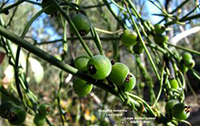Mallee Strangle-vine at Pulletop
 We have all noticed the vines smothering the mallee on our excursions, but this time I stopped for a closer look and noted the multiple root invasion of the vine into the host.
We have all noticed the vines smothering the mallee on our excursions, but this time I stopped for a closer look and noted the multiple root invasion of the vine into the host.
Cassytha melantha (Mallee Strangle-vine, Dodder Laurel, Devil's Twine). Nobody seems to have a good thing to say about it except that it seems to be very effective, although I would have thought that careless killing of the host might not be the best policy. I guess its preference is spreading of new plants by seed rather than survival of the mature vine.
Cunningham in “Plants of Western NSW” says it is “mostly confined to the major areas of mallee in the central east and south west” and “most frequent in mallee communities”. The vine can smother the host which may break under the weight and are often killed.
As usual, Patricia Weare comes good with a drawing in her “Collection of Australian Wildflower Illustrations” and she said “Seeds germinate on the ground but when the stems have parasitically established themselves on the host by means of adhesive cushions, the plant becomes detached from the ground.”
The seeds are globular and fleshy – I wonder if they are a food supply for birds?
And is this plant a mistletoe? Not according to David Watson in his book “Mistletoes of Southern
Australia”. A mistletoe is a “shrubby aerial hemiparasite” - the Strangle-vine is not considered shrubby. (Why are the shrubs we grow in the backyard for grapes called vines then?)
This was noted on a quick trip to Pulleytop Nature Reserve with Max to see what autumn might provide.
Bird life was light on but it was good to see the reliable Yellow-plumed Honeyeaters, and we came across White-eared as well. The mallee in the South-East corner was a cheery colour and shape, on the way back a pair of young Pallid Cuckoos in the Cocoparra Vineyard caught Max's eye, and the day ended with a pair of rain storms – the best time for garden planting.
